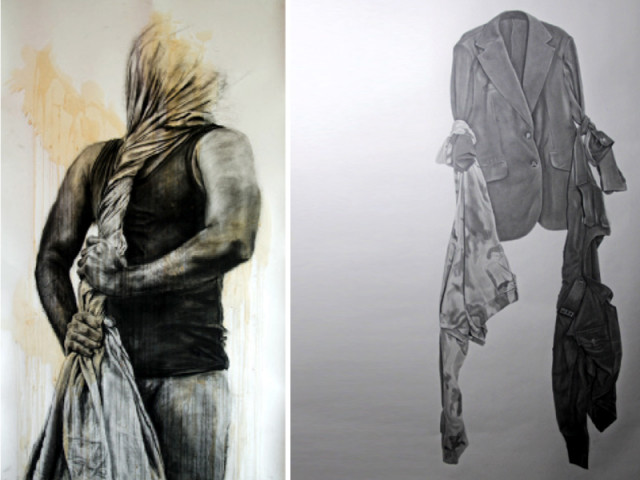They live by night: The dark side of society comes to light at Sanat
Three visual artists displaying works on power and emotional balance in relationships at Sanat Gallery.

Anas Ghauri, Azher Khan and Numair Abbasi’s work went on display on Friday. To show the cries, murder and thrill on fabric, we took the name of the movie, ‘They live by night’, explained Abid Merchant, the director at Sanat Initiative. The works focus on the power, emotional and physical balance and suffocation in relationships in our society.
One of the three artists, Azher Khan, has worked on a series of portraits of policemen, titled ‘Andhera Ujala [Darkness Brightness]’. “I portrayed my frustration and hatred for policemen here,” said the artist, dressed in black shalwar kameez reflecting the theme of his work. Some earlier incidents have left a very negative image of policemen in my mind, he added.
“These portraits carry intense expressions and power,” he explained, pointing to one of his sketches that showed a policeman smoking. Depicting the negative side of a policeman, Khan said he wanted to show the deeper value of the uniform that, according to him, most policemen don’t value.
“If you look at them [portraits], you will feel as if the policeman is gazing at you,” Khan pointed out. The artists admitted with a smile that capturing models in police uniforms and then sketching various expressions was easier instead of portraying real policemen.
Ghauri, on the other hand, used a number of dry lead and graphite mediums to develop a series centred around various arrangements of garments. A recent graduate of the National College of Arts in Lahore, Ghauri also worked in black and white like the other two artists.
The models for his work were asked to wear shirts and trousers upside down and their photos were captured. He then portrayed these images on C A grain drawing paper with a pencil.
The garments in Ghauri’s work do not accurately depict the form of a human body but, he said, he tried to give his work a non-figurative look. “Our lives revolve around the norms of society and we all are punishing one another at some level,” he explained, pointing to a drawing in which a coat was hanging in air while another shirt and army pants were tied to its sleeves.
‘Na Ghar Ka Na Ghat Ka [In pursuit of belonging]’ was the work of the third visual artist, Abbasi, who worked on male dominance, violence, gender discrimination and chaos in society. Abbasi’s depiction of the darkness in life on canvas struck a slightly different string from the rest of the works.
Abbasi worked in layers with paint, charcoal, tea and water to represent the different layers of clothes on a human body. “My characters are mostly engaged in a struggle to get out of the box in their lives,” explained the artist. Since most of his subjects were nude, he admitted that “working boldly and openly in our society is not that acceptable”.
Published in The Express Tribune, December 28th, 2014.

















COMMENTS
Comments are moderated and generally will be posted if they are on-topic and not abusive.
For more information, please see our Comments FAQ